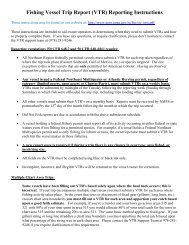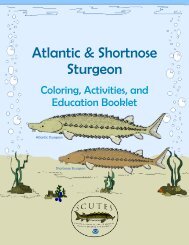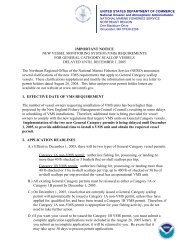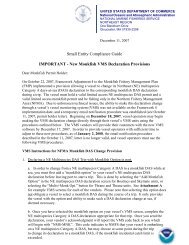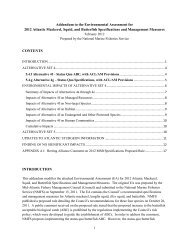modifications to the harbor porpoise take reduction plan - Northeast ...
modifications to the harbor porpoise take reduction plan - Northeast ...
modifications to the harbor porpoise take reduction plan - Northeast ...
Create successful ePaper yourself
Turn your PDF publications into a flip-book with our unique Google optimized e-Paper software.
al., 1997b). The Nor<strong>the</strong>ast Multispecies FMP regulations (50 CFR 648.80) specify a<br />
maximum gillnet panel length of 300 ft (91.4 m or 50 fathoms). However, gillnet<br />
fishermen that are not fishing under a Multispecies or Monkfish permit that are regulated<br />
by <strong>the</strong> HPTRP may use longer nets. As such, <strong>the</strong> HPTRP must clearly indicate that in net<br />
panels that are longer than 300 ft in length, pingers must be spaced 300 or fewer feet<br />
apart.<br />
• A number of Management/Closure Area boundary coordinates and labels will be<br />
modified for clarification, consistency, or correction. Particularly, <strong>the</strong> description of <strong>the</strong><br />
western boundary for <strong>the</strong> exempted waters in Virginia from Chincoteague <strong>to</strong> Ship Shoal<br />
Inlet (currently landward of 37° 52’N, 75° 24.30’W <strong>to</strong> 37° 11.90’N, 75° 48.30’W) as<br />
described in 50 CFR 229.34(a)(2) will be modified by replacing this line with <strong>the</strong> 72<br />
COLREGS demarcation lines <strong>to</strong> be consistent with <strong>the</strong> Bottlenose Dolphin Take<br />
Reduction Plan (BDTRP) and <strong>the</strong> Atlantic Large Whale Take Reduction Plan<br />
(ALWTRP) exemption lines for this area. Additionally, <strong>the</strong> nor<strong>the</strong>rn boundary of <strong>the</strong><br />
Waters off New Jersey Management Area will be changed from <strong>the</strong> existing 40° 40’N<br />
boundary fur<strong>the</strong>r north <strong>to</strong> <strong>the</strong> south coast of Long Island, located at 40° 50.1’N, 72° 30’W<br />
(compare Figure 2-2 with Figure 2-9). Currently, <strong>the</strong> graphic of <strong>the</strong> Waters off New<br />
Jersey Management Area and <strong>the</strong> regula<strong>to</strong>ry text definition of this area in <strong>the</strong> final rule<br />
implementing <strong>the</strong> HPTRP (63 FR 66464, December 2, 1998) do not agree. This revised<br />
definition would make <strong>the</strong> boundary of <strong>the</strong> Waters off New Jersey consistent with 50<br />
CFR 229.34(a)(1), Regulated Waters, and <strong>the</strong> boundary of <strong>the</strong> List of Fisheries definition<br />
of <strong>the</strong> Mid-Atlantic gillnet fishery. O<strong>the</strong>r <strong>modifications</strong> <strong>to</strong> boundaries will correct errors<br />
in labels between regula<strong>to</strong>ry text and graphics within <strong>the</strong> final rule (63 FR 66464,<br />
December 2, 1998), or in tables within <strong>the</strong> regulations (50 CFR 229.33 and 50 CFR<br />
229.34).<br />
• The current regula<strong>to</strong>ry text for restrictions in <strong>the</strong> Mid-Coast Management Area (50 CFR<br />
229.33(a)(2)) neglects <strong>to</strong> state that vessels may fish with <strong>the</strong> use of pingers during <strong>the</strong><br />
“closure” period despite <strong>the</strong> fact that this exemption was indicated in both <strong>the</strong> final EA on<br />
<strong>the</strong> initial HPTRP (NMFS, 1998) and <strong>the</strong> final rule implementing <strong>the</strong> HPTRP (63 FR<br />
66464, December 2, 1998). Both documents describe <strong>the</strong> Mid-Coast Closure Area<br />
regulations as requiring pingers from September 15 through May 31. This regula<strong>to</strong>ry text<br />
will be edited.<br />
• The Mid-Atlantic gear modification regulations (50 CFR 229.34(c)) as described in <strong>the</strong><br />
final rule implementing <strong>the</strong> HPTRP at 63 FR 66464, December 2, 1998) specify both <strong>the</strong><br />
maximum floatline length (string length) and <strong>the</strong> maximum net size allowable within <strong>the</strong><br />
three management areas in this region, indirectly identifying <strong>the</strong> limit on <strong>the</strong> maximum<br />
number of nets per string. Observer data suggest that a large percentage of gillnet gear<br />
exceeds <strong>the</strong> intended maximum level of gear. To ensure clarity, <strong>the</strong> regula<strong>to</strong>ry text will<br />
be amended <strong>to</strong> specify <strong>the</strong> maximum number of net panels allowed per net string in <strong>the</strong><br />
Mid-Atlantic Management Areas.<br />
These technical amendments correct or clarify <strong>the</strong> regulations implementing <strong>the</strong> HPTRP.<br />
Beyond improving comprehension of and associated compliance with <strong>the</strong> measures, <strong>the</strong>se<br />
changes are not expected <strong>to</strong> modify <strong>the</strong> effects of <strong>the</strong> HPTRP and are not analyzed within this<br />
EA. The adoption of <strong>the</strong>se technical amendments received full consensus from <strong>the</strong> HPTRT<br />
during <strong>the</strong> December 2007 meeting.<br />
16



